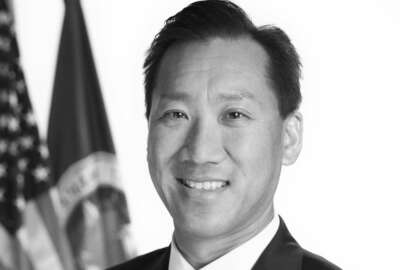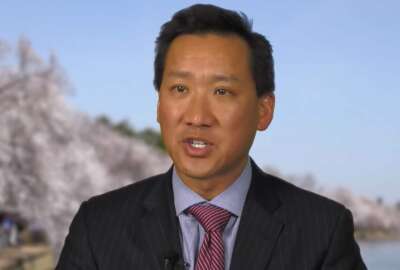Trump administration sees retirement proposals as a ‘downpayment’ for the future, not punishment
Recent proposals to change the existing federal retirement system are just the beginning of coming recommendations from the Office of Personnel Management.
Best listening experience is on Chrome, Firefox or Safari. Subscribe to Federal Drive’s daily audio interviews on Apple Podcasts or PodcastOne.
When it comes to finding ways to modernize the civil service, the Trump administration is very much focused on the future — new employees, new skill sets and new occupations that will transform government from the days of 1978 to 2018 and beyond.
The four familiar proposals the Office of Personnel Management unveiled this week to change the retirement system for current federal employees and retirees is just the beginning of the administration’s push to modernize the federal workforce.
“Those are very, very modest proposals,” OPM Director Jeff Pon said Wednesday morning at a discussion on the “new civil service” at the Partnership for Public Service in Washington. “You should see some other conversations that we will have in the future for restructuring the whole compensation [system] for the federal government.”
Government spends $8.1 billion on retirement per month and $200 billion every year on federal pay and benefits, Pon said. OPM’s recent proposals suggest government would save $143.5 billion over the next 10 years — a small fraction of the current retirement costs, he added.
Federal employees groups have questioned the timing of OPM’s release of the four retirement proposals. But Pon says he needs to move quickly to make meaningful change. The recent proposals are a downpayment on the future, not a punishment, he said.
“I need to make sure that we keep on having progress every single day, because there is a window of opportunity for us to change the civil service and make sure that we accomplish the things in the PMA,” Pon said on Federal Drive with Tom Temin. “They’re downpayments for the long term and the future so that we can start changing things incrementally and holistically.”
For the Trump administration, the future federal workforce looks much different from the current status quo. It sees defined contribution plans as a key to the future.
“We’d like to have a defined contribution program, don’t get me wrong,” Pon said. “I’d like to make sure the federal employee can actually own their investment and take it with them, can come in, come out, and that’s a key component for updating the workforce.”
Pon didn’t expand on the specifics, but he suggested that any future changes that may come to the General Schedule classification system may not impact current employees, but new ones.
Updating the workforce means that agencies have the flexibility to move employees out of government and to new jobs in the private sector, Pon said. Those employees should be encouraged to return to government one day — at a higher General Schedule level than where they left.
In recruiting the next generation of federal employees, the administration wants to consider a “total compensation” package to attract top talent. “Total compensation” includes pay, a portable retirement plan, rewards and recognition — and the natural benefit federal employees receive by simply serving the public, said Margaret Weichert, deputy director for management at the Office of Management and Budget.
“Younger people are being compensated with portable retirement programs, and that is one area where we know we have a huge expense,” she said. “Threading all those together, the goal is not to punish. The goal is obviously not to be out of alignment with the market.”
In the president’s 2019 budget request, the administration proposed the creation of a $50 million central fund to reward certain teams and individuals who pilot innovative ideas.
Weichert cited this fund as evidence that the administration isn’t truly freezing federal pay next year but is instead bettering aligning itself with private sector practices.
Weichert said she’s been surprised by the appetite for change from both long-time and new federal employees.
“One of the things that turns our people off the most is when they feel like they can’t make change happen,” she said. “That was really the most edifying and in some ways surprising learning, that there is a rich vein and desire for change that is untapped in part because people feel like they’re handcuffed by policy and regulation, and frankly, lack of management and leadership.”
The data is also there to support the need for change, both Pon and Weichert said. According to the most recent Federal Employee Viewpoint Survey results, just 31 percent of employees said their agencies reward creativity and innovation. About 36 percent of employees said their managers recognized differences in performance in a meaningful way.
In addition, agency human resources directors are demanding change, said Pon, who has been speaking with chief human capital officers and past OPM directors to collect ideas.
Though OPM and OMB are certainly leading the charge to modernize the civil service, outside organizations such as the Partnership for Public Service and Volcker Alliance are making the case as well.
“We need to do more than admire the problem,” Partnership President and CEO Max Stier said. “We need to do something about it. … It’s high time we actually got action and change.”
Former NASA Administrator Charles Bolden also agreed the federal workforce wants to improve and change. Management and the current civil service system make it difficult for employees to advocate for change, he said.
“For those who are civil servants, [a] message to you,” Bolden said. “You are not the problem.”
Copyright © 2024 Federal News Network. All rights reserved. This website is not intended for users located within the European Economic Area.
Nicole Ogrysko is a reporter for Federal News Network focusing on the federal workforce and federal pay and benefits.
Follow @nogryskoWFED
Related Stories





